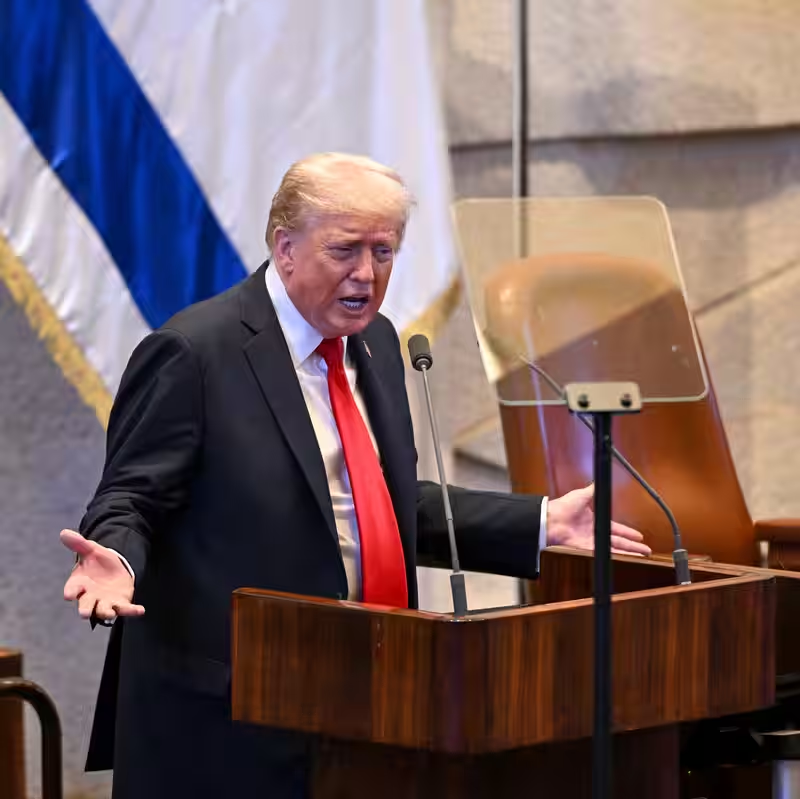Table of Contents
- Trump’s Triumphant Middle East Tour
- What Trump Didn’t Say: Gaza’s Rebuilding Plan Missing
- Global Adulation Meets Domestic Silence
- Who Was Missing from the Peace Summit?
- The Reality on the Ground in Gaza
- Sources
Trump’s Triumphant Middle East Tour
On Monday, October 13, 2025, former U.S. President Donald Trump arrived in Israel just minutes after Hamas released the last 20 living Israeli hostages—a moment hailed as the symbolic end of a brutal two-year war in Gaza. To thunderous applause in the Knesset and chants of “Trump! Trump!” in Tel Aviv’s Hostages Square, he declared: “This is the historic dawn of a new Middle East.”
Wearing a grin and soaking in adulation rarely seen for a foreign leader, Trump addressed Israel’s parliament with sweeping rhetoric: “This is not only the end of a war. This is the end of the age of terror and death.”
Later that day, he jetted to Sharm el-Sheikh, Egypt, where more than 20 world leaders—including Egyptian President Abdel Fattah el-Sisi—gathered for a hastily arranged “peace summit” adorned with banners bearing Trump’s face.
What Trump Didn’t Say: Gaza’s Rebuilding Plan Missing
Despite the fanfare, Trump offered almost no details on the most pressing issue facing the region: what comes next for Gaza?
He made only brief, vague references to reconstruction and the future of the Palestinian people—skipping entirely over how the devastated enclave will be rebuilt, who will govern it, or how 2.3 million displaced and traumatized residents will recover.
“There was zero substance on postwar governance,” said Dr. Noura Erakat, a human rights attorney and Middle East analyst. “You can’t declare a ‘new dawn’ while ignoring the fact that Gaza has no electricity, no clean water, and half its children are malnourished.”
Global Adulation Meets Domestic Silence
Trump’s reception in the Middle East stood in stark contrast to his polarizing status at home. In Tel Aviv, crowds waved Israeli and American flags; in the Knesset, lawmakers donned red “Make Israel Great Again” caps.
Yet back in Washington, critics questioned the sustainability of a peace deal built on emotion rather than architecture. “Celebrating is fine,” said Senator Chris Murphy (D-CT). “But if there’s no plan for day two, we’re just resetting the clock to the next war.”
Who Was Missing from the Peace Summit?
Perhaps the most glaring omission from the Egypt summit was the absence of the two main parties to the conflict: Israel and Hamas.
Israeli Prime Minister Benjamin Netanyahu cited the Jewish holiday of Shemini Atzeret as his reason for skipping the event. Hamas, meanwhile, was not invited—despite having just released all living hostages.
Even more puzzling: no clear document emerged from the summit. Attendees signed a vaguely worded statement about “peace and cooperation,” but diplomats admitted they couldn’t explain its concrete implications.
The Reality on the Ground in Gaza
While Trump basked in applause, Gazans faced a grim reality:
- Over 67,000 Palestinians killed since October 2023 (per Gaza Health Ministry)
- 80% of housing units damaged or destroyed
- Hospitals operating at 10% capacity
- Aid trucks now entering at 600 per day—up from 300—but still insufficient
“The bombing stopped, but our suffering didn’t,” said Fatima Al-Masri, a mother of four living in a tent in Khan Younis. “Who will rebuild our schools? Who will bring back our doctors? Trump didn’t say.”
Without a governance plan, security framework, or reconstruction fund, analysts warn the ceasefire could be fragile. Hamas has refused to disarm; Israel insists it must. And with no Palestinian Authority presence in Gaza, a power vacuum looms.
For now, Trump’s “new dawn” shines brightly in photo ops—but casts long shadows over the unanswered questions that will define whether peace lasts.
Sources
The New York Times: Trump Takes a Victory Lap, but Avoids Questions About What’s Next




